What's the flavor of American coffee beans? What are the coffee producing areas in America? Characteristics of American coffee
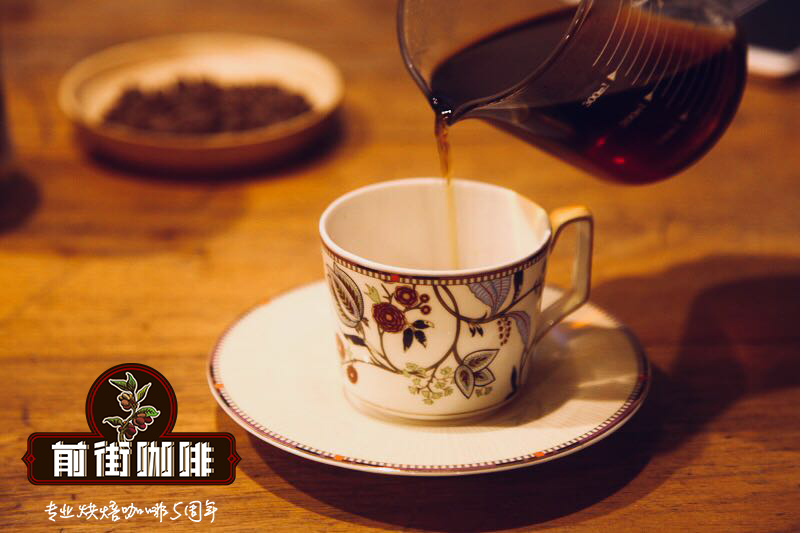
Professional coffee knowledge exchange more coffee bean information please follow the coffee workshop (Wechat official account cafe_style)
The coffee producing areas in the world can be divided into three major ones: America, Africa and Asia. Today Qianjie wants to share with you the coffee producing countries in America. American coffee has a very balanced taste, which is suitable for friends who can not accept bright acidity. Qianjie introduces the origin of America in order to share knowledge and spread value.
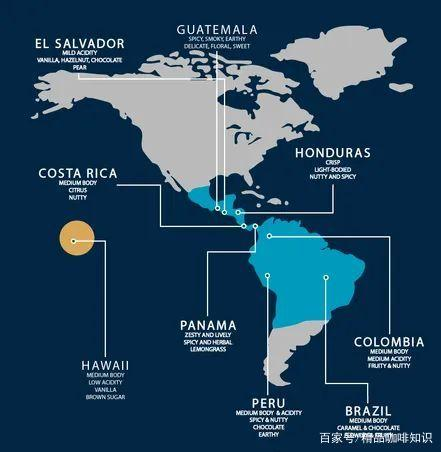
The land bridge between Central America and North and South America consists of seven countries, namely, Colombia, Costa Rica, El Salvador, Guatemala, Honduras, Nicaragua and Panama. Seven Central American countries all produce coffee, of which Guatemala, Costa Rica and Honduras are among the top 10 global coffee exporters.
Coffee began to flourish in Central America in the 18th century, and this important economic product originated in Costa Rica around 1840. Since Central America became independent from Spain in 1821, there has been a lot of war. Costa Rica was far from the Spanish colonial capital Guatemala from the civil war, but Guatemala and El Salvador delayed coffee production because of the civil war. After that, the political dispute gradually subsided, and the Central American countries except Honduras began to produce coffee in the 19th century.
The flavor of Latin American coffee beans is mainly known for its sense of balance and mellow thickness, which is different from that of Asian coffee producing areas. Latin American coffee beans usually show the flavor of cocoa and dark chocolate. Latin American coffee beans are generally treated with water washing and fermentation, while in Brazil, most of them are in half-sun, and the beans are large and complete.
On behalf of countries (regardless of ranking below)
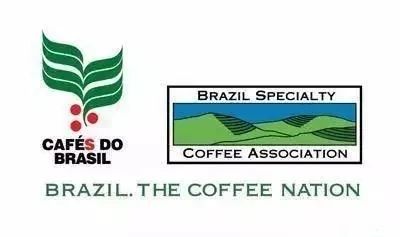
1. Brazil (flavor characteristics: low sour taste, heavy nut chocolate taste, good mellow)
Brazil is the world's largest coffee producer and the world's second largest coffee consumer (the first is the United States). Although Brazil faces several times more natural disasters than other regions, it has enough acreage to make up for it.
[Brazilian coffee bean treatment]
Compared with other Latin American countries, Brazil has a significantly low altitude, lack of microclimate, and is used to planting coffee trees without shade trees, which leads to a slightly insipid flavor of Brazilian coffee beans. There is even a saying in the coffee industry that Brazil does not have good beans (which is also related to the fact that Brazilian coffee did not pay attention to the quality of coffee beans in the past).
However, Brazil still takes great pains to improve the quality of coffee, constantly cultivating and improving Arabica varieties, and changing the coffee bean treatment method according to the dry and wet conditions of the climate to show the best regional flavor. Commonly used treatment methods are sun, half-sun, water washing, generally high humidity producing areas will use water washing, low humidity producing areas will use sun or half-sun.
[Brazilian producing areas]
Brazil has 21 states and 17 states produce coffee, but seven of them produce the most, accounting for 98% of the country's total output. They are: Sao Paulo, Parana, Bahia, Esp í rito Santo, Minas Gerais, Rondo and Rio de Janeiro.
[Brazilian coffee bean grade]
① is graded according to defect rate: there are seven levels of No2- No8 from high to low, and the number of defective beans per 300g is graded. The deduction system is used, and the deduction below 4 can be classified as No2 (No1 without a defective bean is rare and can not maintain a certain supply).
② was graded according to the size of Leguminosae: the highest grade was 17 mesh and 18 mesh.
③ cup quality classification: from high to low, Fine Cup, Fine, Good Cup, Fair Cup, Poor Cup, Bad Cup. FC (Fine Cup) and GC (Good Cup) are more common.
④ flavor grade: from high to low, Strictly Soft is very supple, Soft is very supple, Softish is a little supple, Hardish is not palatable, Rioy iodine choking taste.
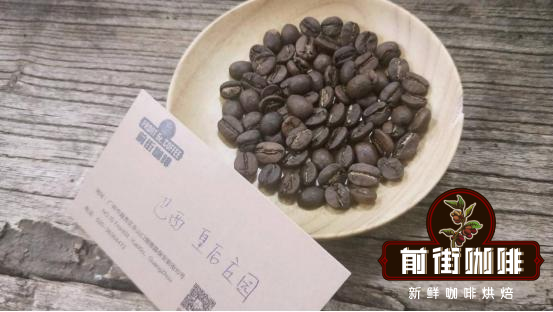
[former Street Coffee Queen Manor Yellow bourbon Coffee beans as an example]
Producing area: Morgiana, Sao Paulo State
Altitude: 1400-1950m
Variety: yellow bourbon
Treatment: insolation
[suggestion on brewing coffee in Qianjie]
Cooking parameters: use Kono filter cup, 88 ℃ water temperature, 15g powder, 1:15 powder / water ratio, medium and fine grinding (BG#6W)
Using segmented extraction, 30 grams of water was steamed for 30 seconds, small water was injected around the circle to 125 grams, and when the water level was about to be exposed to the powder bed, the water injection was stopped to 225 grams, and the extraction time was 2 minutes.
[flavor description]
Taste with obvious sweetness, with a hint of lemon aroma, with a strong nutty flavor, the latter part of the performance has an obvious dark chocolate flavor, the overall feeling is more round.
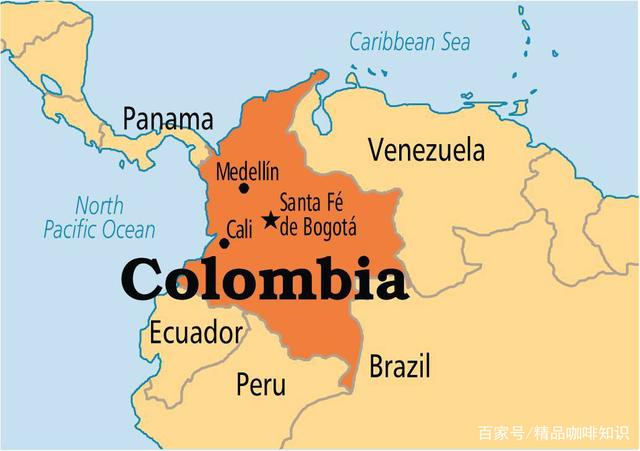
2. Colombia (flavor characteristics: rich and full-bodied aroma, clear acidity, nutty flavor, good balance)
Colombia is the third largest coffee producer in the world, located in northwestern South America, and the climate varies according to the topography. The southern part of the eastern plain and the Pacific coast have a tropical rain forest climate, the mountains with an elevation of 1000-2000 meters have a subtropical climate, and the northwest has a savanna climate. Colombian coffee is not as mellow as Brazilian coffee, and its acidity is not as bright as African coffee, with a good sense of balance, nutty and sour fruit.
[Colombian coffee bean treatment]
Colombian coffee beans are mainly washed with water. Unlike other Latin American countries, Colombia adopts a family-run model, and most coffee growers have their own washing devices, which allow growers to fully control the quality of their own coffee.
Colombian coffee is often compared with Brazilian coffee, because they are both American beans, and they are also large coffee countries. in fact, they do not have to test the flavor, but you can see the difference in the shape of beans, just because of the completely different methods of treatment. as a result, Colombian coffee beans have more silver skins, while Brazilian coffee beans have almost no silver skin. They will be very similar in the size and shape of beans, but they can be clearly distinguished by different treatments.
However, with the development of coffee market, different treatments emerge as the times require. Colombian Rose Valley Coffee and Flower Moon Night Coffee use anaerobic double enzyme washing and anaerobic solarization respectively.
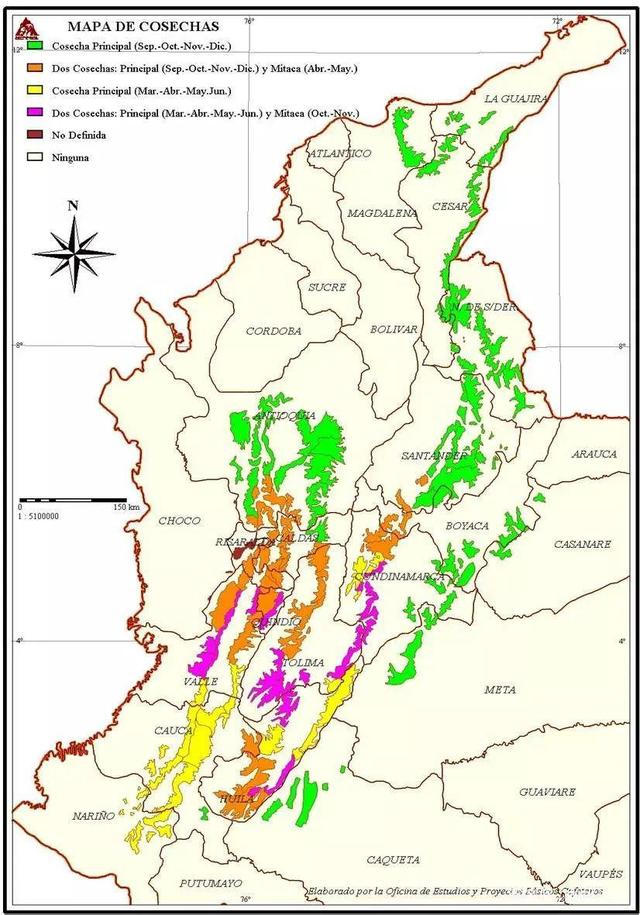
[Colombia production area]
Columbian coffee cultivation is distributed along the Andes Mountains, from south to north, coffee producing areas are divided into four large producing areas: north, central, south and east.
There is only one dry season (December to March) and one rainy season (April to November) each year. Coffee blooms in March, followed by the rainy season, and harvests in October and November. The northern coffee region is subdivided into micro-regions such as Santander, Santander Norte, La Guajira, Magdalena and Cesar.
There are two dry seasons and two rainy seasons each year, from December to February and June to September, and from March to May and September to November, which results in two coffee harvest seasons each year. Micro-regions include Antioquia South, Boiaca, Caldas, Choco, Risaralda, Quindío, Valle del Cauca North, Cundinamarca and Tolima North.
Coffee is grown on a much smaller scale and climatically similar to the north, but with higher rainfall and humidity. It includes only Arauca, Casanare, Meta and Caquetá appellations. The eastern region has suffered armed conflict in the past and coffee production is urgently needed to drive economic recovery. Colombia's National Coffee Producers Association is investing in helping the region grow varieties better suited to its environment, and they are also focusing on helping farmers expand their farms.
Near the equator, coffee grows in higher mountains. As in the north, the south has only one wet season and one dry season. The dry season runs from June to September, with the rainy season coming in October and possibly continuing into May. In contrast to the north, where coffee is harvested in the autumn, and in the south, where the harvest usually begins in April and lasts until June, green bean merchants can provide customers with Colombia coffee beans almost continuously throughout the year. The south is dominated by fine coffee varieties, including Hulia in Huilan, Cauca in Cauca, Nariño (Nalingo) and Tolima in Tolima.
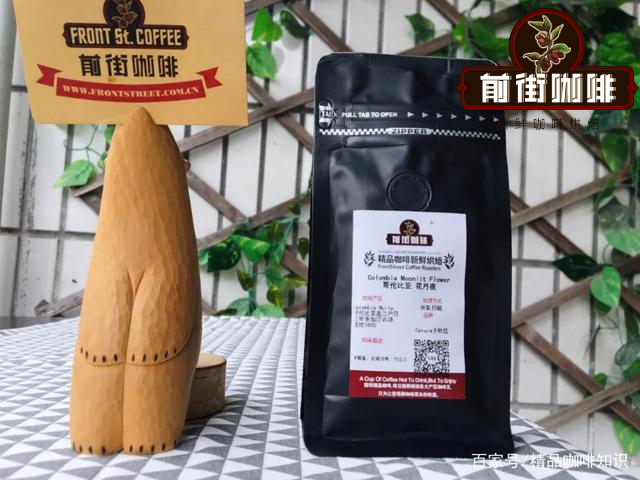
[former street coffee Columbia Flower Moon Night Coffee beans as an example]
Producing area: Huilan
Manor: Estevedoga Manor
Altitude: 1800m
Variety: Kaddura
Treatment method: anaerobic solarization treatment
[suggestion on brewing coffee in Qianjie]
Cooking parameters: using Hario V60 filter cup, 90 ℃ water temperature, 15 g powder, 1:15 powder / water ratio, medium and fine grinding (BG#6S)
Using segmented extraction, 30 grams of water was steamed for 30 seconds, small water was injected around the circle to 125 grams, and when the water level was about to be exposed to the powder bed, the water injection was stopped to 225 grams, and the extraction time was 2 minutes.
[flavor description]
The palate is well balanced with floral strawberries with hints of black cocoa, cream and fermentation.
3. Panama (flavor characteristics: Rose summer as the representative, unique floral aroma and bright acidity)
Panamanian caffeine is famous all over the world, which is closely related to Panama's unique physical and geographical conditions and fine management model. Panama has volcanic ash soil, sufficient air humidity and abundant solar energy resources. After Panama opened the canal at the end of the 20th century, many American elites went south, on the one hand, to demand jobs, and on the other hand, to tap business opportunities. At this time, coffee developed by leaps and bounds, which established Panama's position in boutique coffee.
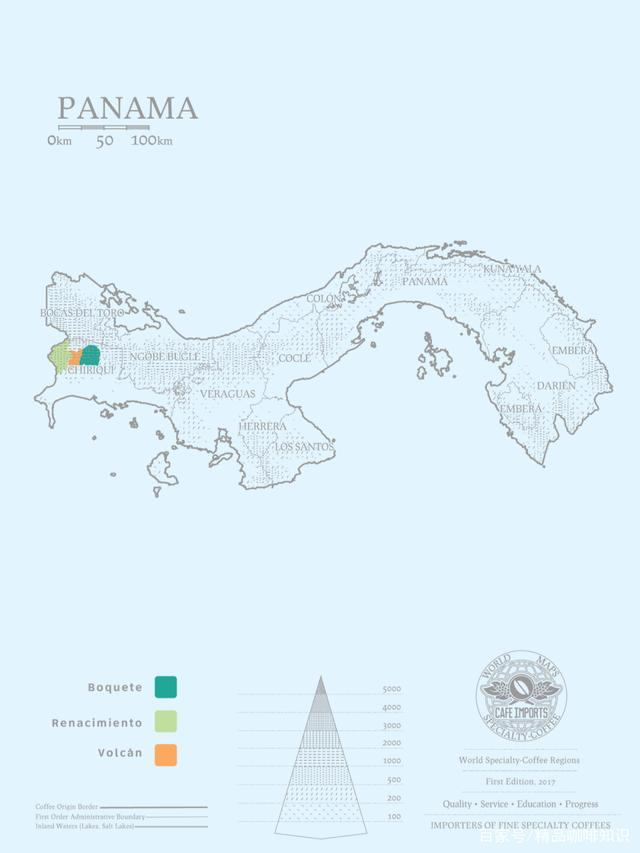
[Panamanian coffee bean treatment]
When it comes to Panamanian coffee beans, most of them are rose summer varieties. In the treatment of rose summer coffee beans, it is common to use water washing and sun treatment, which can reflect the original fragrance and sour flavor of rose summer flowers, and the sun rule adds a sense of richness and sweetness on the basis. In addition, Hartman Manor's red wine treatment is also quite unique, inspired by the red wine brewing process, by controlling the PH value, temperature and humidity to adjust the quality of coffee beans.
[Panamanian producing area]
There are four main coffee producing areas in Panama: Poquet Boquete, Walken Volcan, Santa Clara Santa Clara, Kendra Piedra de Candela.
Pokuit, with an average elevation of 1450 meters, produces the most coffee and the best quality coffee in Panama, such as Emerald Manor, Arida Manor, Catova Manor and so on.
Walken producing area, with an average elevation of 2000 meters, has a mild and balanced coffee feature.
Santa Clara producing area, with an average elevation of 1500 meters, near the Panama Canal, is very convenient for transporting coffee.
The Kendra producing area, with an average elevation of 1200 meters, has attracted more and more attention in recent years, and the industry believes that it has the potential to develop high-quality stunt coffee.
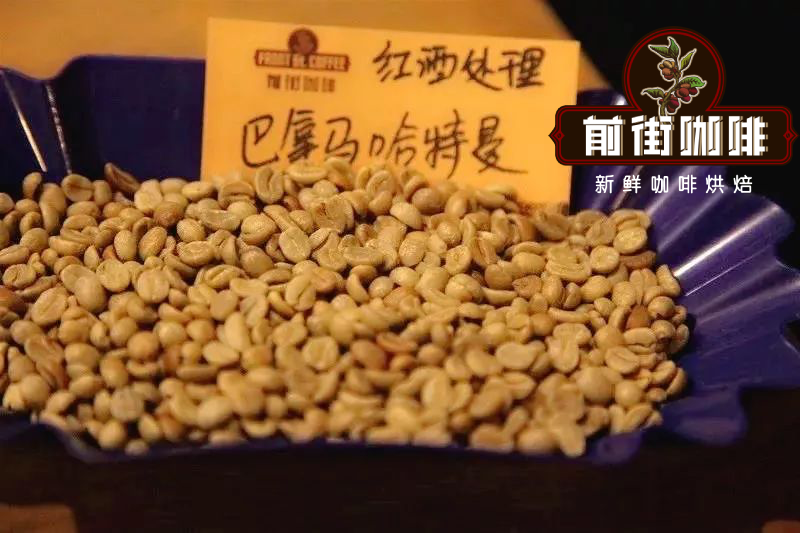
[former Street Coffee Panama Hartman Coffee as an example]
Producing area: Walken
Manor: Hartman Manor
Altitude: 1250-1700m
Variety: Kaduai
Treatment: red wine treatment
[suggestion on brewing coffee in Qianjie]
Cooking parameters: using Hario V60 filter cup, 90 ℃ water temperature, 15 g powder, 1:15 powder / water ratio, medium and fine grinding (BG#6S)
Using segmented extraction, 30 grams of water for steaming for 30 seconds, small water injection to 125 grams, continue to water injection to 225 grams to stop, (steaming starts) extraction time is 2 minutes.
[flavor description]
The texture is mellow, the sweet and sour feeling is obvious, the entrance is smooth and has a very rich red wine taste, high sweetness, lively and bright acidity, rich layers, obvious aftertaste of tropical fruits, nuts, red wine, honey and sucrose, after complete cooling, yellow sugar flavor.
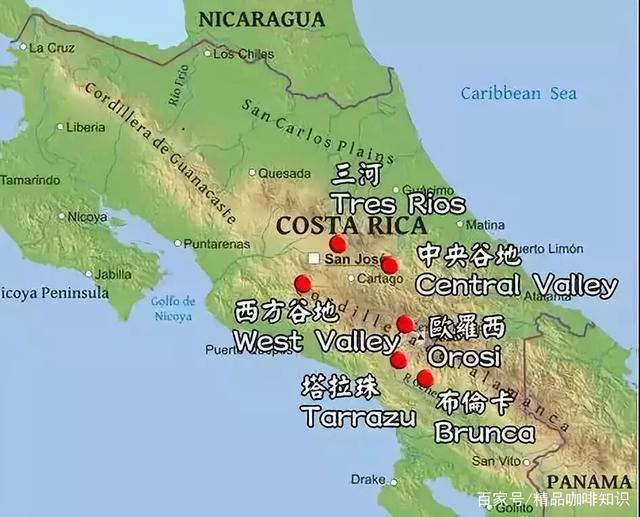
4. Costa Rica (flavor characteristics: nutty, floral toffee flavor, moderate sour and sweet feeling, mellow)
Costa Rica's coffee farming industry started early, is the first in Central America to grow coffee, 1820 has been transported to Europe coffee, and a hit and red, was the British aristocracy known as the "golden bean." After Costa Rica got rid of Spanish colonial rule, the local government began to support the coffee industry with a series of policies, which promoted the development of private plantations. Gradually wealthy coffee farmers sent their children to Europe for further study and returned to China to become doctors and engineers. This shows that coffee farmers have a high status in Colombia. Costa Rica also has laws that allow only Arabica coffee beans to be grown, and Robusta coffee beans are "contraband" in Costa Rica, which is also the first in the world.
Costa Rican Coffee Bean Processing
Costa Rican coffee beans are mostly washed, but the most representative treatment is honey treatment, which is sweeter than washing. Honey treatment is to retain pectin and then drying, after treatment of coffee beans will have sweet as honey flavor. According to the degree of pectin retention, it is also subdivided into white honey, yellow honey, red honey and black honey.
On the basis of honey treatment, raisin honey treatment has also been developed, that is, without peeling, coffee beans are directly placed on the sun bed overnight to shrink their skin and shape like raisins, and then the steps are consistent with conventional honey treatment.
[Costa Rica]
Costa Rica has eight major coffee producing areas: West Valley, Central Valley, Tarrazu, Tres Rios, Orosi, Brunca, Turrialba, Guanacaste. Among them, Central Valley, Tarazhu and Three Rivers are the most famous.
Tarazhu is located in the south of the capital San Jose, 1200-1700 meters above sea level, fertile soil, good drainage, coffee production season from December to March of the following year. The main characteristics of coffee beans produced by it are the incomparable perfect taste created by high altitude producing areas, smooth taste, firm and full body of beans, and rich flavor.
The central valley is between 1200 and 1600 meters above sea level, and the production season is November to March of the following year. There are three high-altitude volcanoes in the region: Irazu, Barva and Poas, which provide rich nutrients for the surrounding coffee producing areas. The microclimate, combined with volcanic fertility, gives the beans of the Central Valley a chocolate cocoa flavor and elegant aroma. The region has three sub-regions: San Jose, Heredia and Alajuela.
Three rivers producing area, located in the east of the capital not far from the Irazhu volcano, elevation in 1200-1650 meters, production season for December to March of the following year. In recent years, urban areas have gradually spread to the suburbs, and agricultural land has been sold to developers, resulting in a sharp drop in coffee production in Sanhe District. Starbucks has almost taken over most of the production, and it is difficult for the industry to buy. Three Rivers well-known farm Aquis Grasse opened since 1857, has a long history. The climate conditions in Sanhe producing area are good, and the coffee beans produced taste balanced very well.
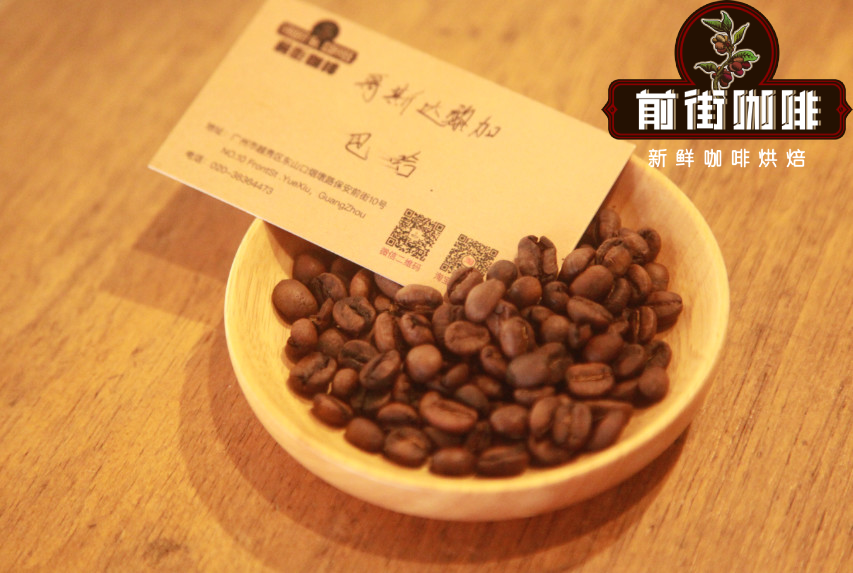
[former street coffee Costa Rica Bach coffee beans as an example]
Producing area: Tarazhu
Manor: Carnett Manor
Altitude: 1950m
Variety: Kaddura
Treatment: raisin honey treatment
[suggestion on brewing coffee in Qianjie]
Cooking parameters: using Hario V60 filter cup, 90 ℃ water temperature, 15 g powder, 1:15 powder / water ratio, medium and fine grinding (BG#6S)
Using segmented extraction, 30 grams of water was steamed for 30 seconds, small water was injected around the circle to 125 grams, and when the water level was about to be exposed to the powder bed, the water injection was stopped to 225 grams, and the extraction time was 2 minutes.
[flavor description]
It has fermented aroma of rice wine, sweet and sour taste of ripe tropical fruits and berries, nutty and creamy flavor, caramel in Huigan and a hint of flowers in the finish.
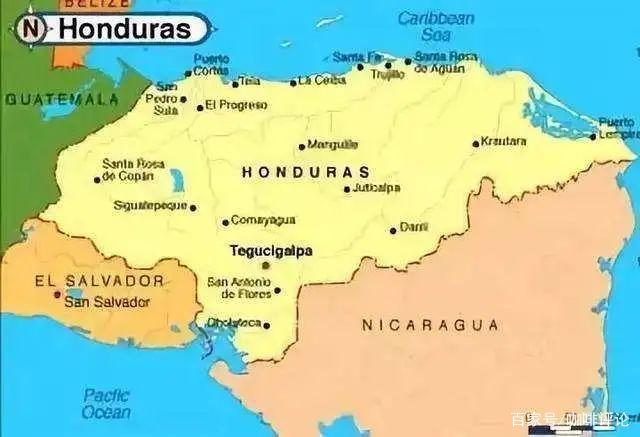
5. Honduras (flavor characteristics: balanced and supple, sour and slightly sweet, high mellow and aroma)
The coffee industry in Honduras has developed quite late, far less than most of the countries around Central America. With the full support of the government and drawing lessons from the development model of Brazil, the coffee industry in Honduras has gradually developed. In particular, in 2010, the involvement of Japanese boutique coffee made Honduras have the potential to become a superstar. Since 2011, Honduras has surpassed Guatemala in coffee production to become the largest coffee producer in Central America and one of the top 10 coffee producers in the world.
Most of the Honduran coffee is sold to Europe, and Germany is the main supplier of Honduran coffee, importing nearly 40 million kilograms of Honduran coffee every year. Although some Honduran coffee is sold to the United States and Japan, sales are not as impressive as in Europe.
There are 280000 hectares of coffee plantations in Honduras, mainly small coffee plantations, most of which are less than 3.5ha. These coffee plantations account for 60 per cent of all coffee production in Honduras.
[Honduran coffee bean treatment]
Most of the high-quality coffee in Honduras is washed, which can retain the original flavor of coffee beans. In addition, on the basis of water washing, the barrel fermentation water washing method is derived. Shirley coffee beans, which are very popular recently, are treated by refined water washing whisky Shirley barrel fermentation. The freshly picked coffee fruit is carefully washed, then put into a barrel ripe into sherry and fermented at a low temperature for 30-40 days (about 15-20 ℃), before drying in the shade.
Honduran coffee can be divided into six major producing areas, mainly located in the west and south of the Coban region (Copan), Obalaka region Opalaca), Mondesius (Montecillos), Gongma Agua (Comayagua), Agalta Tropical (Agalta Tropical), Parasso (El Paraiso). Among them, there are three major producing areas:
Montecius: the highest altitude producing area in Honduras, the coffee is bright and layered, full of rich fruit and sweet aromas, with citrus aromas.
Koban area: coffee beans in this area have chocolate flavor, mellow taste and high sweetness.
Akata: the coffee beans in this area have a sense of honey sweetness and acidity balance, and have chocolate tonality.
However, the recent hot sherry coffee beans and lychee orchid coffee beans are not from the above six producing areas, but from Masaguara, a city in Intibu á province in southwestern Honduras.
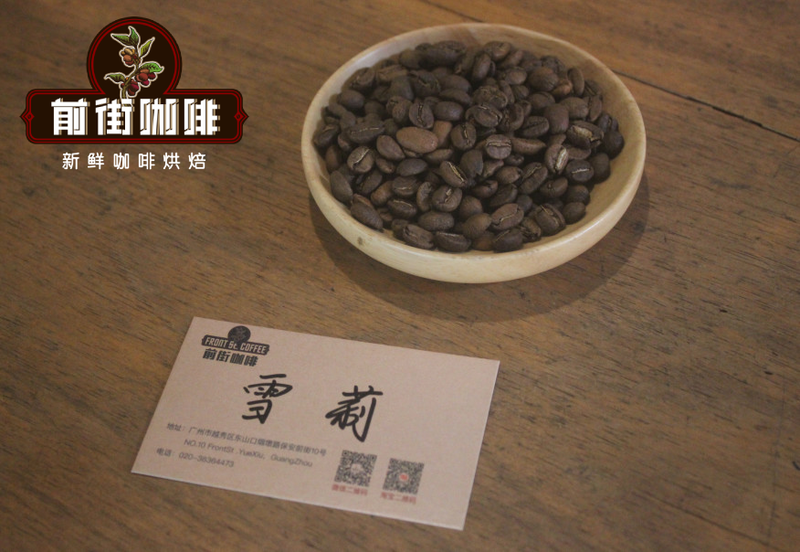
[former street coffee Honduras Shirley coffee beans as an example]
Producing area: Masaguara
Manor: Moca Manor
Altitude: 1500-1700m
Variety: Kaddura, Kaduai, Pacas
Treatment: fine washed whisky Shirley barrel fermentation
[suggestion on brewing coffee in Qianjie]
Cooking parameters: using Hario V60 filter cup, 90 ℃ water temperature, 15 g powder, 1:15 powder / water ratio, medium and fine grinding (BG#6S)
Using segmented extraction, 30 grams of water was steamed for 30 seconds, small water was injected around the circle to 125 grams, and when the water level was about to be exposed to the powder bed, the water injection was stopped to 225 grams, and the extraction time was 2 minutes.
[flavor description]
The mouth has aromas of vanilla and cream, sour notes of citrus and berries, almonds and dark chocolate in the middle, maple syrup in the end, vanilla in the finish, clear flavor and smooth taste. The flavor is stable from hot to cold, and there is no other miscellaneous flavor.
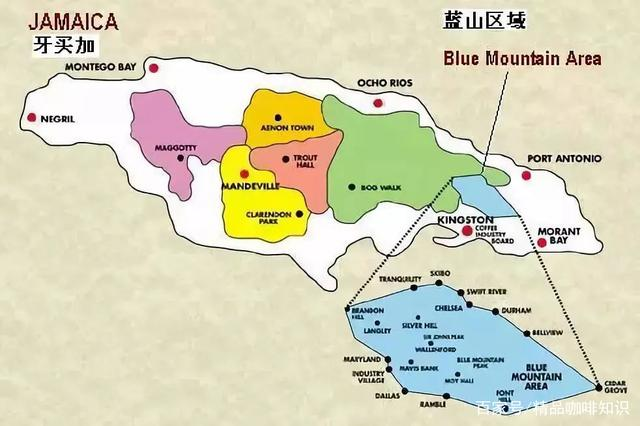
6. Jamaica Blue Mountain (flavor features: full-bodied, mellow, sweet, sour and bitter)
Jamaica is an island in the Caribbean. Jamaica's Blue Mountains are the highest in the Western Caribbean (2256m above sea level, only below 1700m can stop coffee, above is a protected forest). Blue Mountain is located in the coffee belt of 25 degrees north latitude, with fertile volcanic soil, fresh air, year-round rain, high humidity, large temperature difference between day and night, regular rainfall and under the hazy clouds on the island, keep the coffee trees away from the hot sun.
[Jamaica Blue Mountain Coffee Bean treatment]
Jamaica Blue Mountain coffee beans are mainly washed with water. This is to ensure the standard flavor of Blue Mountain Coffee, but this year we all have some luck. The sun version of Blue Mountain Coffee has been successfully produced. The sun treatment of Blue Mountain Coffee can be said to be an unprecedented innovative attempt, and the R & D team has also gone through thousands of experiences. Not only can it be exported without washing raw beans with the permission of the Ministry of Agriculture of Jamaica, but also to inspect and learn from the experience of excellent manors many times to adjust the treatment plan.
[Jamaica Blue Mountain Coffee Bean grading]
There are three grades of coffee in the Blue Mountains of Jamaica: blue Mountain Coffee (Blue Mountain Coffee), Alpine Coffee (Jamaica High Mountasin Supreme Coffee Beans) and Jamaican Coffee (Jamaica Prime Coffee Beans).
There are grades under the Blue Mountain Coffee. From high to low is: blue Mountain No. 1, Blue Mountain No. 2, Blue Mountain No. 3, PB (also known as public beans, round beans).
Blue Mountain No. 1 (No.1): 96% of raw beans are 17x18-mesh beans, with a defect rate of less than 2%.
Blue Mountain No.2 (No.2): 96% of raw beans are 16x17-mesh beans, with a defect rate of less than 2%.
Blue Mountain No. 3 (No.3): 96% of raw beans are beans with 15 grams and 16 mesh, with a defect rate of less than 2%.
PB:96% raw beans are PB, and the defect rate is less than 2%.
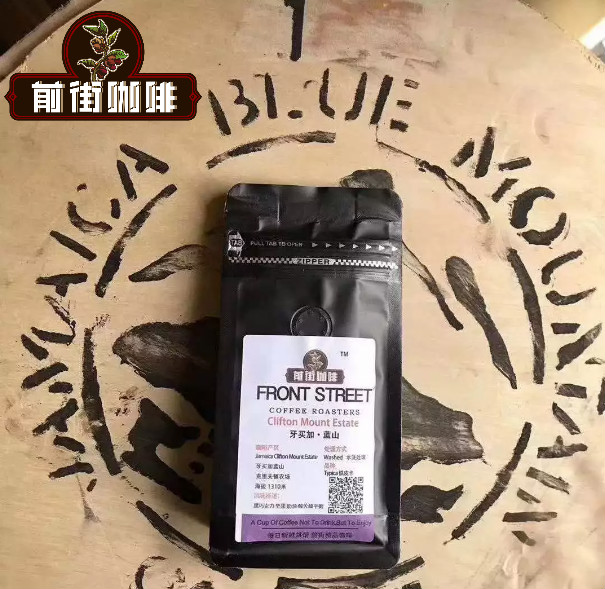
[former street coffee Jamaica Blue Mountain coffee beans as an example]
Producing area: blue Mountain
Manor: Clifton Manor
Altitude: 1310m
Variety: iron pickup
Treatment: water method
[suggestion on brewing coffee in Qianjie]
Cooking parameters: use Kono filter cup, 88 ℃ water temperature, 15g powder, 1:15 powder / water ratio, medium and fine grinding (BG#6W)
Using segmented extraction, steaming 30 grams of water for 30 seconds, injecting water around the circle to 125 grams, continuing to inject water to 225 grams when the water level is about to reveal the powder bed, and the extraction time is 2 minutes.
[flavor description]
The palate is clean and mild, full-bodied and mellow, with dark chocolate, nuts, cream, sweet and sour.
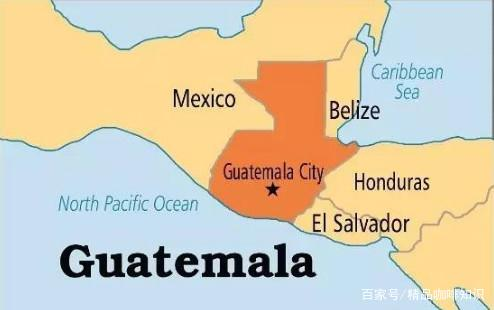
7. Guatemala (flavor characteristics: fruity, sweet and sour balance)
Although the territory of Guatemala is small, it is endowed with tropical rain forests, volcanic geology, plateau valleys and changeable micro-climate. These various geographical factors have created the unique coffee flavor of Guatemala.
The average altitude of Guatemala is high, and the coffee belt is distributed above 1500m above sea level. It is the easiest to grow extremely hard beans, and the proportion of high-quality beans is very high, mainly growing bourbon, Tibica, Kaddura and Kaduai coffee beans.
[Guatemalan Coffee Bean treatment]
Guatemala coffee bean washing method is mainly, the sun method as a supplement. The washing method ensures the fruity flavor of Guatemalan coffee beans, on the basis of which the sun rule enhances its richness and hierarchy.
[Guatemala producing area]
Guatemala is divided into eight major producing areas, five volcanic producing areas and three non-volcanic producing areas, namely Antigua, traditional Attland, Koban Rain Forest, New Oriental, San Marcos Volcano, Akatilando Valley, Vivi Plateau and Farrakhan Nice Plain.
Even in the same producing area, the flavor may not be the same. For example, in the Wei Wei Plateau, across a mountain, the flavor of coffee can immediately feel a great change. Coupled with the increasing diversity of varieties and treatments, the flavor of coffee presents a situation in which a hundred schools of thought contend.
[non-volcanic producing areas]
Among the three major non-volcanic coffee producing areas in Guatemala, the Weiwei Plateau has the driest climate and the highest altitude. Coffee bean flavor is characterized by high acidity, bitter and fragrant, with wine aftertaste, good taste.
Koban rainforest producing area, the biggest feature of this region is rainforest, which has two seasons a year, heavy rainy season and light rainy season. The tropical rainforest in this area is accompanied by high humidity and sufficient nutrients. The most important feature of coffee flavor is the strong fruit flavor, which is closely related to the high local humidity.
The New Oriental region, located in the easternmost part of Guatemala, has the latest start of coffee farming and was once the most remote and poorest area in Guatemala. The rainy and foggy characteristics make it somewhat close to the Koban rainforest, but with slightly less moisture and rainfall. The soil is rich in minerals and balanced in nutrition. Coffee beans are characterized by a balanced taste, mellow thickness and chocolate flavor, but the acidity is the lowest of the eight Guatemalan regions, and chocolate is the main feature of New Oriental.
[volcanic producing area]
Antigua, one of the most famous coffee producing areas in Guatemala, has the highest award frequency and is called "classic". Its main characteristics are rich volcanic soil, low humidity, sufficient sunshine and large temperature difference between day and night. This area is surrounded by three volcanoes: Agua, Fuego and Acatenango. Fuego is one of the three most active volcanoes in Guatemala. Due to the frequent occurrence of local volcanoes, volcanic pumice can maintain moisture and provide a continuous stream of volcanic ash and minerals for the soil of the region, overcoming the lack of rainfall in Antigua, creating a very balanced flavor of local coffee.
Akatilange Valley producing area, up to 2000 meters above sea level, dense shade and unique ecology, nearby volcanoes continue to erupt, making the soil rich in various fertile minerals and becoming the best local natural fertilizer. Coffee is mainly processed by family-style traditional methods. The flavor of coffee beans is similar to that of Antigua, but the acidity is slightly lower, the dry and wet aroma is remarkable and pleasant, the mellow thickness is full, the aftertaste is clear and the aroma is refreshing.
In the traditional Atilan producing area, among the five major volcanic regions, the organic composition in the soil is the most abundant. The area has long accumulated excellent planting and processing techniques. 90% of the coffee is grown on the severe volcanic slopes on the shores of Lake Attilan. it's about 1300-2000 meters above sea level. Coffee beans are characterized by mild acidity, bright orange peel aroma and good mellowness.
Farrakhan Nice Plain producing area, volcanic producing area, high altitude, rich in minerals in the soil, coffee bean flavor tends to be balanced, but has a more unique aroma and flavor than Antigua.
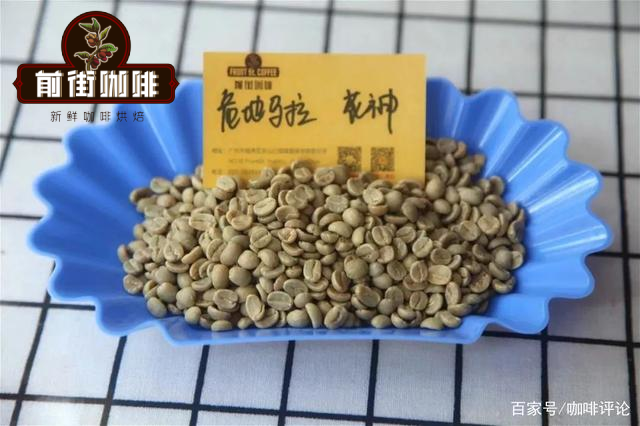
[former street coffee Antigua flower god coffee beans as an example]
Producing area: Antigua
Manor: Raminita Manor
Altitude: 1850m
Varieties: bourbon, Kaddura, Kaduai
Treatment method: washing treatment method
[suggestion on brewing coffee in Qianjie]
Cooking parameters: using Hario V60 filter cup, 90 ℃ water temperature, 15 g powder, 1:15 powder / water ratio, medium and fine grinding (BG#6S)
Using staged extraction, 30 grams of water was steamed for 30 seconds, small water was injected around the circle to 125 grams, and continued to be injected to 225 grams. The extraction time was 2 minutes.
[flavor description]
Citrus acid is more obvious, rich floral aroma, pleasant sweetness, medium mellow, the latter part has a slight caramel feeling, the whole is balanced and clean, smooth texture.
Important Notice :
前街咖啡 FrontStreet Coffee has moved to new addredd:
FrontStreet Coffee Address: 315,Donghua East Road,GuangZhou
Tel:020 38364473
- Prev
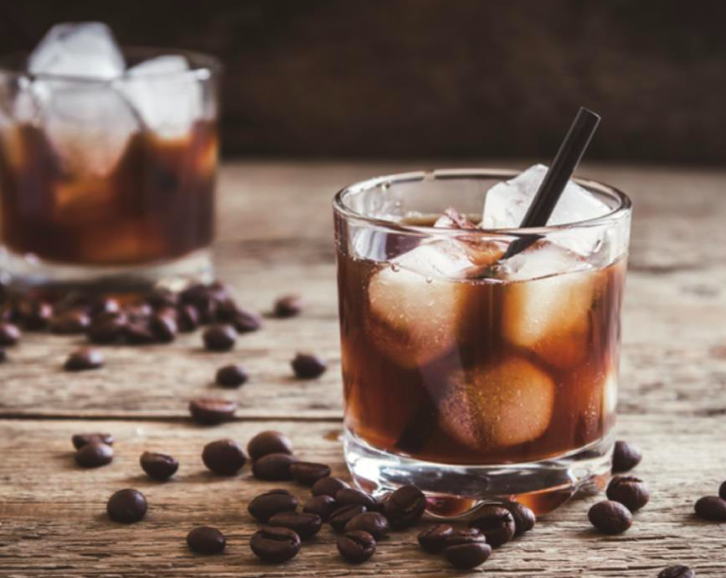
Cold brewed coffee has low caffeine content and high antioxidant activity. Research shows that hot coffee is better!
Professional Coffee knowledge Exchange more information about coffee beans Please follow the coffee workshop (Wechat official account cafe_style) what you should know about cold-brewed coffee, such claims as lower caffeine content or higher antioxidant power are actually misleading myths. Because the temperature is more conducive to the solubility of many molecules, and can change the structure of the coffee powder, so that it was originally held tightly by the coffee.
- Next
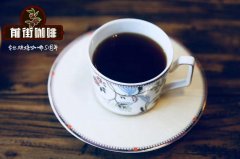
Is Blue label Rose Summer the same as Blue Mountain Coffee? How to avoid astringency in Blue Mountain Coffee?
Professional coffee knowledge exchange more coffee bean information please follow the coffee workshop (Wechat official account cafe_style) the blue mark is the rosy summer from the jadeite estate in Panama. Emerald Manor in 1996, the Peterson family bought a coffee farmer in Boquete, the Jaramillo region of Camelot.
Related
- Detailed explanation of Jadeite planting Land in Panamanian Jadeite Manor introduction to the grading system of Jadeite competitive bidding, Red bid, Green bid and Rose Summer
- Story of Coffee planting in Brenka region of Costa Rica Stonehenge Manor anaerobic heavy honey treatment of flavor mouth
- What's on the barrel of Blue Mountain Coffee beans?
- Can American coffee also pull flowers? How to use hot American style to pull out a good-looking pattern?
- Can you make a cold extract with coffee beans? What is the right proportion for cold-extracted coffee formula?
- Indonesian PWN Gold Mandrine Coffee Origin Features Flavor How to Chong? Mandolin coffee is American.
- A brief introduction to the flavor characteristics of Brazilian yellow bourbon coffee beans
- What is the effect of different water quality on the flavor of cold-extracted coffee? What kind of water is best for brewing coffee?
- Why do you think of Rose Summer whenever you mention Panamanian coffee?
- Introduction to the characteristics of authentic blue mountain coffee bean producing areas? What is the CIB Coffee Authority in Jamaica?

